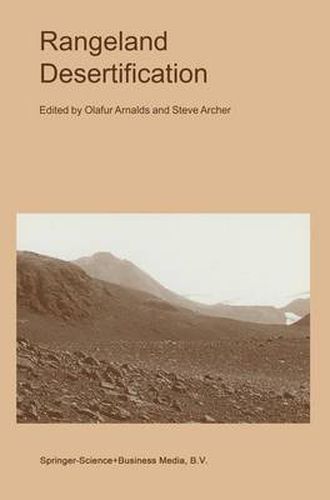Readings Newsletter
Become a Readings Member to make your shopping experience even easier.
Sign in or sign up for free!
You’re not far away from qualifying for FREE standard shipping within Australia
You’ve qualified for FREE standard shipping within Australia
The cart is loading…






This title is printed to order. This book may have been self-published. If so, we cannot guarantee the quality of the content. In the main most books will have gone through the editing process however some may not. We therefore suggest that you be aware of this before ordering this book. If in doubt check either the author or publisher’s details as we are unable to accept any returns unless they are faulty. Please contact us if you have any questions.
Desertification has occurred worldwide. The biophysical and socio-economic complexity of this phenomenon has challenged our ability to categorize, inventory, monitor and repair the condition of degraded lands. One of the most important distinctions to be made in relation to land degradation is between cultivated land used for annual crop production and “rangelands’. Grazing by free-roaming livestock is the traditional primary use of the world’s rangelands. However, there is growing recognition of the importance of these vast acreages for wildlife habitat, hydrology and ground water recharge, recreation and aesthetics.
This text focuses on the desertification of rangelands and explores processes, problems and solutions. Chapters in the first section evaluate interactions between "natural’ and human-induced disturbance regimes, thresholds, and non-linear change with respect to vegetation, hydrology, nutrients and erosion. Chapters in the second section examine socio-economic constraints and approaches for preventing and reversing degradation.
The book provides a contemporary, process-oriented perspective on rangeland degradation of value to students, policy-makers and professionals alike.
$9.00 standard shipping within Australia
FREE standard shipping within Australia for orders over $100.00
Express & International shipping calculated at checkout
This title is printed to order. This book may have been self-published. If so, we cannot guarantee the quality of the content. In the main most books will have gone through the editing process however some may not. We therefore suggest that you be aware of this before ordering this book. If in doubt check either the author or publisher’s details as we are unable to accept any returns unless they are faulty. Please contact us if you have any questions.
Desertification has occurred worldwide. The biophysical and socio-economic complexity of this phenomenon has challenged our ability to categorize, inventory, monitor and repair the condition of degraded lands. One of the most important distinctions to be made in relation to land degradation is between cultivated land used for annual crop production and “rangelands’. Grazing by free-roaming livestock is the traditional primary use of the world’s rangelands. However, there is growing recognition of the importance of these vast acreages for wildlife habitat, hydrology and ground water recharge, recreation and aesthetics.
This text focuses on the desertification of rangelands and explores processes, problems and solutions. Chapters in the first section evaluate interactions between "natural’ and human-induced disturbance regimes, thresholds, and non-linear change with respect to vegetation, hydrology, nutrients and erosion. Chapters in the second section examine socio-economic constraints and approaches for preventing and reversing degradation.
The book provides a contemporary, process-oriented perspective on rangeland degradation of value to students, policy-makers and professionals alike.